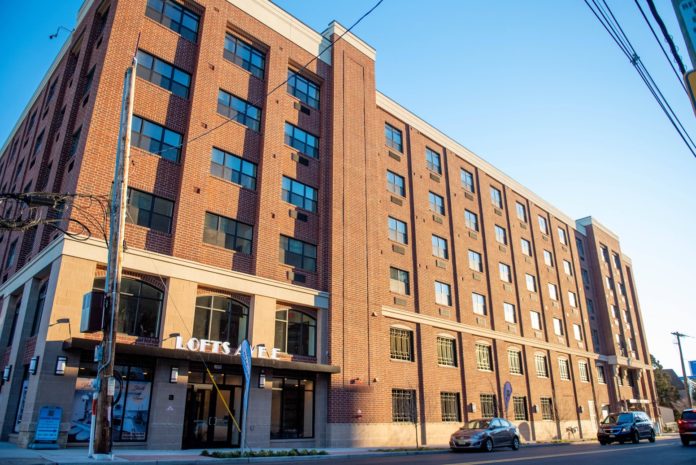
Bayonne city officials have formally presented the results of the much-anticipated absorption rate study to the public.
The study was commissioned by the City Council at the request of Mayor James Davis back in July of 2022. After the study was commissioned, La Pelusa announced in November that it had concluded and the results and that the data was promising.
This likely means that redevelopment and the financial agreements that support it may be back on the agenda regularly fairly soon.
Preliminary data announced in November
According to Council President Gary La Pelusa, the absorption rate is the amount of housing stock a community has available to sell or lease, and how quickly it is being sold or rented.
The study looked at the total number of new residential dwelling units and multiple dwelling developments built in the city of Bayonne after January 1, 2015, the number of units occupied and unoccupied, new units expected in multi-unit developments over the next 24 months, the amount of tax and other revenue realized by the city as a result of multi-unit residential development completed after January 1, 2015, and the amount of tax and or other revenue the city would have realized if these properties were not developed.
An occupancy rate is the number of units being occupied over the total amount of units available. La Pelusa said that high occupancy rates show the demand for people wanting to live in that area. Since 2009, there have been 20 residential redevelopments constructed featuring 2,978 units. He said these buildings were 92.6 percent occupied.
This number includes buildings that are currently in their lease up phase, La Pelusa said. The average stabilization for buildings that have been leased up is about 94.6 percent occupied. According to La Pelusa, the lease up period is an indicator of the absorption.
The buildings currently in their lease up period are being leased “at a breakneck pace” of five to six months, La Pelusa said. Meanwhile, the industry standard is up to 12 months. He noted that in one example, a building was fully leased up within two to three months.
According to La Pelusa, the minimum occupancy rate per federal standards is 75 percent. Given the data, the city’s occupancy rate is way above that. La Pelusa said the current occupancy rate is even higher than its 10-year historical average of 91.372 percent, according to data from Rutgers University.

Official findings of Bayonne’s absorption rate study
At its January meeting, La Pelusa had financial advisor from NW Financial Mike Hanley come up to the podium in the chambers to address the council. Hanley presented the facts of the absorption study to the council and the public.
He explained that the city collected data from all the new developments in the city in recent years to determine if their was sufficient occupancy related to the residential projects. He said the empirical data collected looked promising.
“The results were very strong,” Hanley said.
Of the over 2,500 new units that were leased, the occupancy was above 95 percent. He added that many of them exceeded 97 percent occupancy.
“That’s good or better than you would look for,” Hanley said. “Additionally, a project that was currently leasing up at the time had reported 66 units in three months, over 20 units per month, which is excellent. A mean historical rate of 10 to 12 is something that you would consider good under-riding a project.”
According to Hanley, these are not unexpected results. He said the city knew anecdotally that the projects were doing well and that Bayonne and the region needed units.
Hanley also said Up for Growth’s 2022 Housing Underproduction in the United States study, that included Bayonne, echoed this. The study identified that there are 340,000 units shortfall in the New York metropolitan area, of which 200,000 are rental units and 140,000 are homes.
According to Hanley, low rates of home vacancy was an issue prior to COVID-19 pandemic but made even worse by it. He said that rental vacancy are also at a low not seen in decades.
“Both before COVID, and now it’s been exacerbated after COVID, the number of vacancies are at an all time low in new homes,” Hanley said. “Generally, there’s like 1 percent vacancy. It’s the lowest since 1957. As it relates to rental units, the vacancy rates are the lowest since 1984, and it’s because we’ve seen an influx in the population and we haven’t built quickly enough in the region.”
Absorption rate study echoes regional ‘Up for Growth’ study
Hanley said that the data in the absorption rate study was consistent with this. The new units built are mostly occupied, meaning the new redevelopment is warranted to supply more of much needed housing stock to accommodate the shortfall.
“The data that the city identified in its data collection is very consistent with what we’re seeing throughout the region,” Hanley said. “It doesn’t matter whether it’s Hackensack or Union Township or Weehawken. Everywhere has the same problem. Homes are very expensive. They are very few to even find. So people need opportunities and more affordable places to live. The city is obviously the most expensive, and as you go further out, people can get either more space or the same amount of space at a better price. That’s why institutions continue to invest in new units and Bayonne’s place in that marketplace is important. The results prove that to be true.”
La Pelusa asked about the scope of the Up for Growth study, which Hanley confirmed was of the New York City metropolitan area. He said that included New York, Connecticut, and New Jersey, and that the results of the study are something that many people have experienced first hand when it comes to trying to purchase a home or rent an apartment.
“I think we all have experienced, either as ourselves or with friends or relatives etcetera, that buying a home is super hard and super expensive,” Hanley said. “There’s not enough rental units because they’re all snatched up very quickly. Adding to the housing stock is what will ultimately make the region more affordable.”
There was still some confusion on the council, with Second Ward Councilwoman Jacqueline Weimmer asking if the absorption study focused on just Bayonne, meaning that roughly 95 percent of recently constructed units are occupied. Hanley confirmed that while the other study related to the region, the absorption study was just about Bayonne.
“That high 90 percent range is where occupancy is and that is because there aren’t enough places to live for all people who need places to live,” Hanley said.

Confused council confirms correct count
Clarifying on the numbers, La Pelusa asked that if the housing shortage constituted 340,000 units and 200,000 were rentals, were the others for-sale homes. Hanley confirmed that was the case.
“Their study thought that the split between what was needed was of that 342,000, 200,000 of the need was rental and another 140,000 was for sale property,” Hanley said.
Weimmer asked if unit sizes were taken into account, noting many are studio units and one-bedroom units, with few two-bedrooms. Concerned about overcrowding in schools with new students brought in by redevelopment, she noted that the younger demographic isn’t looking to own a home as much as rent a space, and asked if those factors were considered as well as.
“Its a continuum,” Hanley said. “The shortfalls across all housing types as it relates to school children and their populations. That study doesn’t address it, but Rutgers University has studied that multiple times. They did an initial study, I believe in 2012, that identified multiplies for units and how many school children they tend to attract. Small units have very few. Particularly new ones, because they’re expensive and small. If you’re going to pay a lot and you have a lot of people living with you, you need more space.”
According to Hanley, these types of units, such as what was built in Bayonne, do not typically bring more school-aged children. He said that the aforementioned study on it was adjusted after such occurrences were noted.
“They even lowered the multiple in 2018 and 2019 because the newer units were producing fewer school children,” Hanley said. “So people that were going to places that were more transit-oriented, and also the type and the way the units were being built, created even fewer school children than the initial study had projected. So they redid the study at the behest of the towns and developers to more appropriately reflect what was going on.”
Davis touts Bayonne meeting housing demand
In January 2022, Mayor Davis placed a pause on most major residential redevelopment pending the completion of a study on the occupancy rate of the buildings constructed amid the redevelopment boom in Bayonne since Davis took office.
The pause came amid the run up to the May municipal election which Davis narrowly won, largely in response to the now-approved 18-story Silk Lofts tower on Avenue E, and also saw a pause also placed on the financial agreements that support them. However, some projects were granted approval regardless, which officials defended was due to prior planning approvals.
Regardless, there was some sort of slow down on residential redevelopment until the study was completed. Meanwhile, the city began the redevelopment process of the massive Constable industrial area in the city, comprising 20 percent of Bayonne.
After the meeting, Davis told the Bayonne Community News that the study confirmed what many already knew. Bayonne is a hot spot for renters and that the smart growth of the community will continue to meet the housing demand while preserving the character of the city.
“The absorption study confirmed that Bayonne is a popular real estate market for renters,” Davis said. “Bayonne’s growing supply of housing is keeping up with the demand for it. Our convenient location in the heart of the metropolitan area has made Bayonne an attractive location for New York commuters. We must take care to have smart development while maintaining the fabric of our community.”
For updates on this and other stories, check www.hudsonreporter.com and follow us on Twitter @hudson_reporter. Daniel Israel can be reached at [email protected].









